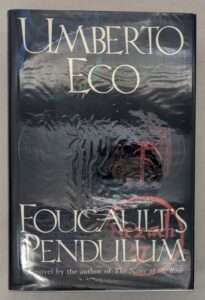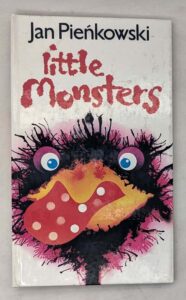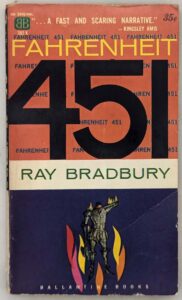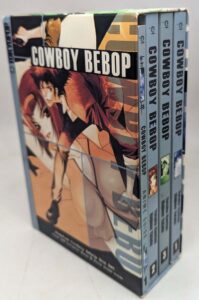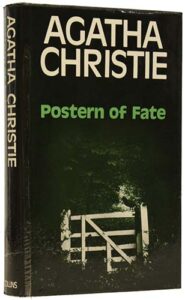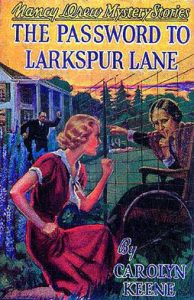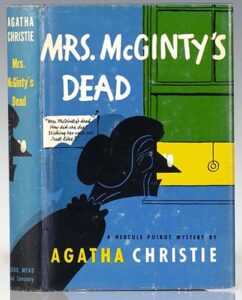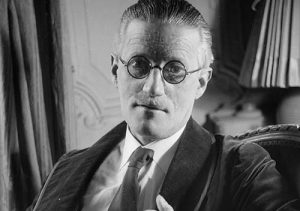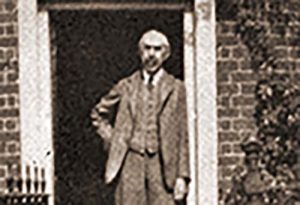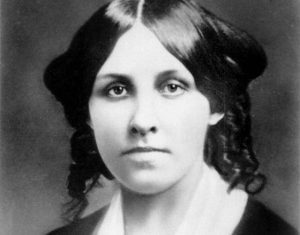Curtain: Poirot’s Last Case is a work of detective fiction by British writer Agatha Christie, first published in the UK by the Collins Crime Club in September 1975 and in the US by Dodd, Mead and Company later in the same year, selling for $7.95.
The novel features Hercule Poirot and Arthur Hastings in their final appearances in Christie’s works. It is a country house novel, with all the characters and the murder set in one house. Not only does the novel return the characters to the setting of her first, The Mysterious Affair at Styles, but it reunites Poirot and Hastings, who last appeared together in Dumb Witness in 1937. The fictional detective dies at the end.
It is the last novel published by Christie before her death. Sleeping Murder, published posthumously, is her final novel.
Plot Summary
[SPOILER ALERT]
A specific person is unsuspected of involvement in five murders by both the police and family of the victims. In all cases, there was a clear suspect. Four of these suspects have since died (one of them hanged); in the case of Freda Clay, who gave her aunt an overdose of morphine, there was too little evidence to prosecute. Poirot calls-on his old friend, the recently-widowed Hastings, to join him in solving this case. Poirot alone sees the pattern of involvement. Poirot, using a wheelchair due to arthritis, and attended by his new valet Curtiss, will not share the name of the previously unsuspected person, using X instead. X is among the guests at Styles Court with them. The old house is a guest hotel under new owners, Colonel and Mrs Luttrell. The guests know each other, with this gathering initiated when Sir William Boyd-Carrington invites the Franklins to join him for a summer holiday stay. The five prior murders took place in the area, among people known to this group.
Elizabeth Cole tells Hastings that she is a sister of Margaret Litchfield, who confessed to the murder of their father in one of the five cases. Margaret has died in Broadmoor Asylum and Elizabeth is stigmatised by the trauma. Three incidents occur in the next few days, showing the imprint of X. First, Hastings and others overhear an argument between the Luttrells. Shortly afterwards, Luttrell wounds his wife with a rook rifle, saying he mistook her for a rabbit. Mrs Luttrell recovers, and the incident has a good effect on their marriage. Next, Hastings is concerned that his daughter Judith spends time with Major Allerton, a married man. While Hastings and Elizabeth are out with birdwatcher Stephen Norton, Norton sees something through his binoculars that disturbs him. Hastings assumes it has to do with Allerton. When his attempts to persuade Judith to give Allerton up merely antagonise her, the worried father plans Allerton’s murder. He falls asleep while waiting to poison Allerton, relieved he took no action when he awakes the next day. Last, Barbara Franklin, wife of Judith’s employer, Dr Franklin, dies the following evening. She was poisoned with physostigmine sulphate, an extract from the Calabar bean that her husband researches. Poirot’s testimony at the inquest, that Mrs Franklin had been upset and that he saw her emerge from Dr Franklin’s laboratory with a small bottle, persuades the jury to return a verdict of suicide.
Norton is still concerned over what he saw days earlier when out with Hastings and Cole. Hastings advises Norton to confide in Poirot. They meet in Poirot’s room. That night, Hastings is awakened by a noise and sees Norton entering his bedroom. The next morning, Norton is found dead in his locked room with a bullet-hole in the centre of his forehead, the key in his dressing-gown pocket and a pistol nearby.
When Hastings tells Poirot that he saw Norton return to his room the night before, Poirot says it is flimsy evidence, not having seen the face: the dressing-gown, the hair, the limp, can all be imitated. Yet, there is no man in the house who could impersonate Norton, who was not tall. Poirot dies of a heart attack within hours. He leaves Hastings three clues: a copy of Othello, a copy of John Ferguson (a 1915 play by St. John Greer Ervine), and a note to speak to his longtime valet, Georges. After Poirot is buried at Styles, Hastings learns that Judith has all along been in love with Dr Franklin. She will marry him, and leave to do research in Africa. When Hastings speaks to Georges, he learns that Poirot wore a wig and that Poirot’s reasons for employing Curtiss were vague.
Four months after Poirot’s death, Hastings receives a manuscript in which Poirot explains all. X was Norton, a man who had perfected the technique of which Iago in Othello (and a character in Ervine’s play) is master: applying just such psychological pressure as is needed to provoke someone to commit murder, without his victim realising what is happening. Norton had demonstrated this ability, with Colonel Luttrell, with Hastings, and Mrs Franklin. Poirot intervened with sleeping pills in Hastings’ hot chocolate that night, to avert a disastrous rash action. Ironically, Hastings had unwittingly intervened in Mrs. Franklin’s plan to poison her husband, by turning a revolving bookcase table while seeking a book to solve a crossword clue (Othello again), thus swapping the cups of coffee, so Mrs Franklin poisoned herself. Poirot could not prove this. He sensed that Norton, who had been deliberately vague about whom he had seen through the binoculars, would hint that he had seen Franklin and Judith, to implicate them in the murder of Mrs Franklin, not inadvertent suicide as it was. This explains Poirot’s testimony at her inquest, to ensure the police would stop their investigation.
Given his very weak heart, Poirot conceives that he must end the string of murders by killing Norton. Poirot invites Norton for hot chocolate: at their meeting, he tells Norton what he suspects and his plan to execute him. Norton, arrogant and self-assured, insists on swapping cups: anticipating this move, Poirot had drugged both cups, knowing that he had a higher tolerance for a dose that would incapacitate Norton. Poirot moves the sleeping Norton back to his room using the wheelchair: Poirot could walk all along, one reason he needed a new valet who was unaware of that for this last case. Then, being the same height as Norton, he disguises himself as Norton by removing his wig and false moustache, ruffling up his grey hair, then donning Norton’s dressing-gown and walking with a limp. Having Hastings establish that Norton was alive after he left Poirot’s room, Poirot shoots Norton, leaves the pistol on the table and locks the room with a duplicate key. Poirot then writes his story, and ceases to take his amyl nitrite heart medicine. He cannot say it was right to commit murder, but on balance he was sure he prevented yet more instigated by Norton. His last wish for Hastings is typical for Poirot, the matchmaker: he suggests that Hastings should pursue Elizabeth Cole.
Publication history
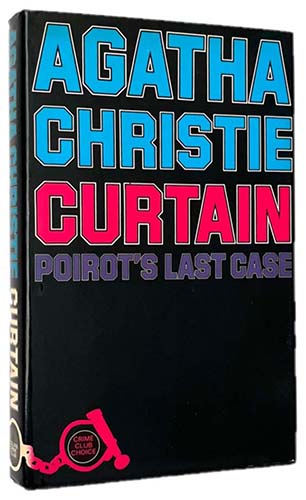
Christie wrote the novel in the early 1940s, during World War II. Partly fearing for her own survival, and wanting to have a fitting end to Poirot’s series of novels, Christie had the novel locked away in a bank vault for over thirty years. The final Poirot novel that Christie wrote, Elephants Can Remember, was published in 1972, followed by Christie’s last novel, Postern of Fate. Christie authorised Curtain‘s removal from the vault and subsequent publication. It was the last of her books to be published during her lifetime.
Though publication was in 1975, and the novel was written over 30 years earlier, the exact time period of the story is unknown, beyond it being summertime. The age of Hastings’ daughter puts the story after the Second World War, as does the complete absence of wartime conditions and restrictions, but nothing sets a specific post-war year. The story clearly ends Poirot’s career, as he dies in the novel, using his death for a resolution he had never before considered for a murderer: to become one himself. Poirot’s death was announced in The New York Times, a rare honour for a fictional character.
Publication history
- 1975, Collins Crime Club (London), September 1975, Hardcover, 224 pp ISBN 0-00-231619-6
- 1975, Dodd Mead and Company (New York), Hardcover, 238 pp, ISBN 0-396-07191-0
- 1976, Pocket Books (New York), Paperback, 280 pp
In the US the novel was serialised in Ladies Home Journal in two abridged instalments from July (Volume XCII, Number 7) to August 1975 (Volume XCII, Number 8) with an illustration by Mark English.
Curtain – First Edition Book Identification Guide
The books are listed in the order of publication. While the majority of Agatha Christie’s books were first published in the UK. There are many titles that were first published in the US. The title of the book may differs from the UK edition in some cases.
| Year | Title | Publisher | First edition/printing identification points |
|---|---|---|---|
| 1975 | Curtain | William Collins & Sons, London, [1975] | First edition. "First Published 1975" stated on the copyright page. Black cloth lettered in silver. Price £2.95. |
| 1975 | Curtain | Dodd, Mead & Co, NY, [1975] | First American edition. "© Agatha Christie, Ltd., 1975" stated on the copyright page. Cream boards, blue cloth spine lettered in gold. Price $ 6.95. |
Note about Book Club Editions (BCE) and reprints:
UK: You can see statements of later reprint dates or of book club on the copyright page.
US: The US reprint publishers usually use the same sheets as the first edition and are harder to identify by looking at the title page or the copyright page. One may identify a BCE by looking at the DJ, which doesn’t have a price on top of the front flap and a “Book Club Edition” imprint at the bottom. If the dust jacked is clipped at both the top/bottom of the front flap. You can safely assume it’s a BCE . If the book is missing the dust jacket. Later BCE editions can be identified by its plain boards, while first printings are issued in quarter cloth.
Please refer to the gallery for detailed images of true first edition bindings and dust jackets.
Curtain – First Edition Dust Jacket Identification Guide
First edition bindings and various dust jacket printings identification.

